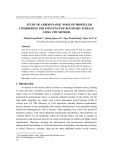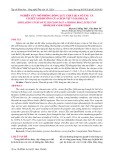
REGULAR ARTICLE
On the influence of the americium isotopic vector on the cooling
time of minor actinides bearing blankets in fast reactors
Timothée Kooyman
*
, Laurent Buiron, and Gerald Rimpault
CEA, DEN, DER, SPRC, Bat 230, Cadarache, 13108 Saint Paul lez Durance, Cedex, France
Received: 30 August 2017 / Received in final form: 31 January 2018 / Accepted: 20 March 2018
Abstract. In the heterogeneous minor actinides transmutation approach, the nuclei to be transmuted are
loaded in dedicated targets often located at the core periphery, so that long-lived heavy nuclides are turned into
shorter-lived fission products by fission. To compensate for low flux level at the core periphery, the minor
actinides content in the targets is set relatively high (around 20 at.%), which has a negative impact on the
reprocessing of the targets due to their important decay heat level. After a complete analysis of the main
contributors to the heat load of the irradiated targets, it is shown here that the choice of the reprocessing order of
the various feeds of americium from the fuel cycle depends on the actual limit for fuel reprocessing. If
reprocessing of hot targets is possible, it is more interesting to reprocess first the americium feed with a high
243
Am content in order to limit the total cooling time of the targets, while if reprocessing of targets is limited by
their decay heat, it is more interesting to wait for an increase in the
241
Am content before loading the americium
in the core. An optimization of the reprocessing order appears to lead to a decrease of the total cooling time by 15
years compared to a situation where all the americium feeds are mixed together when two feeds from SFR are
considered with a high reprocessing limit.
1 Introduction
Minor actinides are three heavy nuclides created in reactors
core as by-products of the chain reaction by successive
captures on uranium and plutonium isotopes. Several
isotopes of these elements can be found in spent nuclear
fuel, namely:
–
237
Np for neptunium, produced by captures on
235
Uor
(n,2n) reactions on
238
U
–
241
Am,
242m
Am and
243
Am for americium, produced by
captures on plutonium and decay of
241
Pu
–
242
Cm,
243
Cm,
244
Cm,
245
Cm,
246
Cm for curium,
produced by captures on americium isotopes.
–Higher isotopes of Berkelium and Californium are rarer
but some of them, such as
252
Cf can be dimensioning to
their very high neutron source. They are mostly produced
in thermal reactors loaded with MOX fuel.
In the context of a closed fuel cycle where plutonium is
multi-recycled in fast reactors [1], minor actinides become
the main responsible for the long-term radiotoxicity of the
nuclear waste [2]. Additionally, they are generating most of
the decay heat of the waste packages, which is a
dimensioning parameter of final deep geological reposito-
ries [3]. However, it is possible to effectively remove the
minor actinides from the waste by implementing minor
actinides transmutation.
Transmutation is the process of submitting minor
actinides to a neutron flux in order for them to undergo
fission and then obtain shorter-lived fission products. A
successful removal of all the minor actinides from the waste
would reduce the long-term radiotoxicity of the spent fuel
by two orders of magnitude while divide by two the volume
to be excavated and save 33% in the total footprint of a
deep geological repository taking into account all common
infrastructures [4]
Thermal reactors are not adapted to minor actinides
transmutation due to unfavorable capture to fissionratioand
the necessity of a closed fuel cycle associated with
transmutation, as discussed in [5]. Consequently, this paper
will focus on minor actinides transmutation in fast reactors,
and more specifically, sodium fast reactors. Furthermore,
since complete destruction of a significant mass of minor
actinides in a single irradiation is currently not achievable
due to material resistance constraints (see the prohibitively
long residence time discussed in [6] for instance) multi-
recycling of the minor actinides will be considered here.
Two main approaches can then be highlighted for
transmutation in fast reactors:
–The homogeneous approach, in which minor actinides are
mixed with the fuel and loaded at the core center. In this
*email: timothee.kooyman@cea.fr
EPJ Nuclear Sci. Technol. 4, 11 (2018)
©T. Kooyman et al., published by EDP Sciences, 2018
https://doi.org/10.1051/epjn/2018007
Nuclear
Sciences
& Technologies
Available online at:
https://www.epj-n.org
This is an Open Access article distributed under the terms of the Creative Commons Attribution License (http://creativecommons.org/licenses/by/4.0),
which permits unrestricted use, distribution, and reproduction in any medium, provided the original work is properly cited.

case, they are exposed to a high neutron flux, which
increases the efficiency of the process. However, this leads
to a hardening of the neutron spectrum of the core which
has negative impacts on the core integral feedback
coefficients [7]. Additionally, this leads to a “pollution”of
the entirety of the fuel cycle plants, along with a lack of
flexibility in the irradiation conditions of the minor
actinides as these would depend on industrial constraints
linked with fuel depletion.
–The heterogeneous approach, in which minor actinides
are loaded in dedicated targets, generally located at the
core periphery. In this approach, the perturbation on the
core neutron spectrum is very limited and no modifica-
tions of the feedbacks coefficients can be observed.
However, as the targets are located in a low-flux zone, the
transmutation process is less efficient than in the
homogeneous case. To compensate for this, the residence
time is generally increased along with the mass loaded in
the blankets. However, this has a negative impact on the
decay heat of the irradiated targets, which ultimately
leads to prohibitively long cooling times.
This paper will focus on the heterogeneous approach to
minor actinides transmutation and especially americium
heterogeneous transmutation. Indeed,
237
Np has a half-life
of 2.16 10
6
years, making it relatively harmless while
americium isotopes are shorter-lived, with a half life of 7370
years for
243
Am and 432 years for
241
Am, which are the
main isotopes to be found in the waste. Curium is generally
not considered in transmutation studies as its very high
decay heat and neutron source highly complicates the
manufacturing of curium-bearing fuels [8–10].
Irradiation of americium in radial blankets leads to the
production of curium isotopes which have a very high
neutron source and decay heat rate. Prior to reprocessing,
the assemblies must be removed from the core, washed
from the residual sodium and transported to a reprocessing
plant. Due to technological limitations linked to the
temperature of the assemblies and handling devices during
all these operations, such assemblies requires longer cooling
times to reach acceptable heat load before reprocessing can
occur. This increases the total inventory of minor actinides
in the fuel cycle (either in the core, in manufacturing or
cooling down), while this inventory should be minimized in
order to limit the movements of minor actinides in the fuel
cycle. The dependency of the cooling time to the americium
isotopic vector will be analyzed here and various strategies
will be discussed to limit the cooling time of the minor
actinides bearing blankets (MABB).
2 Position of the problem and methodology
2.1 Analysis of the problem
Current industrial limitations considered regarding reproc-
essing of MABB can be divided into two categories [11]:
–Short term handling of the assemblies for movement to
external storage. Depending on the technology consid-
ered, various limitations can be taken. For a revolving
drum similar to the Superphénix design, the assembly
heat load can be arbitrarily high. However, if an external
cask is used, a maximal decay heat can be fixed at 40 kW
for sodium cooling cask and 30 kW for cask with cooling
by forced gas convection.
–Sodium washing of the assemblies before transportation
to the reprocessing plant. After an initial cooling period
in sodium, the assemblies must be drained of their sodium
content and washed using various techniques (carbon-
ation, sodium water reaction) to remove residual sodium
before they can be stored under water in cooling pools.
Industrial limitations on washing of the spent fuel
assemblies depend on technological research, therefore a
minimal and a maximal value of respectively 2.5 and
7.5 kW will be considered here, as done in [11].
In this study, a minimal cooling time of 5 years will be
considered before sodium washing can occur and it will be
supposed that reprocessing occurs directly after sodium
washing has been performed. Five years of minimal cooling
time is a standard hypothesis of the French scenarios
studies, as it can be found in [12].
If we consider a reference MABB, loaded with
U
0.8
Am
0.2
O
2
with 75% of
241
Am and 25% of
243
Am and
irradiated for 4100 EFPD in a SFR-V2B reactor, as
discussed in [13], it is possible to analyze the contribution to
decay heat and neutron source after 5 years of cooling, as it
is done in Table 1. The depletion calculations were carried
out using the DARWIN code system [14]. Nearly 98% of the
heat is produced through alpha-decay of heavy nuclides,
with
244
Cm being the main heat emitter with close to 50%
of the total power production, followed by
238
Pu and
241
Am. Concerning neutron source, spontaneous fissions of
244
Cm is responsible for 96% of the total neutron source of
the spent fuel [14].
242
Cm has a very weak contribution to
decay heat after 5 years of cooling due to its short half-life.
Considering this, it is necessary to study the formation
route of these nuclei, as it is done below in equation (1). It is
thus possible to split the contribution to decay heat
depending on the half-lives of the nuclei considered and
their parent-nuclei. Thus, the long-term decay heat will be
more dictated by
241
Am and
238
Pu, thus depending on the
initial
241
Am content while neutron source and shorter-
term decay heat will be depending on
244
Cm and thus on
243
Am initial content.
241
Am concentration will also play a
role for the very-short term handling of the irradiated fuel,
Table 1. Main heat emitters in a MABB cooled for 5 years
after 4100 EFPD of irradiation, with 75%
241
Am and 25%
of
243
Am.
Power in W/g Fraction of
total power (%)
Half life
Alpha 5,79E-02 97,88
Beta 7,69E-04 1,30
Gamma 4,84E-04 0,82
244
Cm 2,88E-02 48,60 18.1 years
238
Pu 1,71E-02 28,93 87.8 years
241
Am 9,66E-03 16,33 432 years
242
Cm 1,73E-03 2,93 162 days
Total 5,92E-02 1,00E + 00
2 T. Kooyman et al.: EPJ Nuclear Sci. Technol. 4, 11 (2018)

mainly due to
242
Cm contribution to decay heat. This is
summarized in Figure 1, which plots the contribution of
each nuclide to the total decay heat versus time. It can be
observed that
242
Cm dominates short term decay heat, while
244
Cm contribution peaks around 5–10 years, which is the
typical time scale of a nuclear reprocessing cycle. Finally,
238
Pu and
241
Am dominate the long-term decay heat.
241
95Am þ1
0n! 242m
95Am
241
95 Am þ1
0n!242
95 Am b;T1=2¼16 h
! 242
96 Cm a;T1=2¼162d
! 238
94 Pu
ð1Þ
243
95 Am þ1
0n! 244
95 Am b;T1=2¼10 h
! 244
96 Cm:
Going back to the reprocessing limits considered above,
it can be observed that depending on the current
reprocessing limit, the main contributor to the decay heat
will not be same. Consequently, the cooling time of the
assemblies will depend both on the americium isotopic
vector loaded in the blankets and on the reprocessing limit,
as shown in Figure 2. In this figure, the cooling time was
plotted with regards to the fraction of
241
Am in the
americium irradiated for various decay heat limit.
It is observed that the slope of the cooling time
evolution changes of sign depending on the limit consid-
ered. For high decay limit, the cooling time decreases with
the
241
Am fraction as the short-term decay heat depends on
244
Cm production. Consequently, the decay of
244
Cm only
is sufficient to reach an acceptable decay heat, and any
decrease in the
243
Am content will decrease the
244
Cm
production. On the other hand, for low limits, the cooling
time increase with the
241
Am fraction. Indeed, in this case,
the decay of
244
Cm is not sufficient to achieve a final decay
heat lower than the limit, and it is necessary to wait for
241
Am and
238
Pu decay to reach the limit, which requires a
much longer time. Consequently, an increase in the
241
Am
fraction will increase the cooling time for such cases.
Considering this, it is postulated here that depending
on the industrial constraint for reprocessing and on the
availability of various americium fluxes in the fuel cycle, an
optimization can be carried out to minimize the cooling
time of the irradiated targets at any given time.
3 Analysis of the available americium feeds
The americium isotopic vector present in the fuel depends
on various parameters which are:
–The initial fissile content of the fuel : an UOX fuel will
generate more
241
Am than
243
Am compared to a MOX fuel.
–The neutron spectrum:
243
Am production will be higher
in a thermal spectrum than in a fast spectrum due to
increased captures on
242
Pu.
–The fuel burn up : a higher burnup will increase the
production of
243
Am due to increased captures on
242
Pu.
–The plutonium isotopic vector used in the fuel: a higher
quality of the plutonium will limit the production of
243
Am, where the quality of the plutonium is defined by
its content in “good”fissile elements, e.g.
239
Pu and
241
Pu.
The plutonium isotopic vectors used in this study are
given in Table 2.
–The spent fuel cooling time before reprocessing: once
reprocessing is carried out, the production of
241
Am from
the decay of
241
Pu is stopped. A short cooling time will
limit the amount of
241
Am produced and then increase
the
243
Am content in the americium, while a longer
cooling time will increase the content in
241
Am.
An analysis of the various isotopic vectors that can be
obtained is shown below in Table 3. At unloading, the ratio
of
241
Am to
243
Am is found to be between 78% and 51%
depending on the core considered, while after 5 years of
cooling, which is the minimal time of cooling generally
considered, this ratio oscillates between 85 and 65%.
Considering a 2 kW reprocessing limit in Figure 2, this
amounts to a difference of 23 years in the cooling time,
Fig. 1. Evolution of the various contributions to total decay heat
versus time.
Fig. 2. Cooling time for various limiting values depending on the
fraction of
241
Am in the americium isotopic vector. A minimal
cooling time of 5 years was considered.
T. Kooyman et al.: EPJ Nuclear Sci. Technol. 4, 11 (2018) 3

which is not negligible. For a 2.5 kW limit, the difference is
only of 2 years. If we consider a very long cooling time
during which all the
241
Pu decays, the final ratio varies
between 83 and 94%, still leading to a significant difference
for low reprocessing limit.
We will consider here heterogeneous transmutation of
americium for three cases, in which either the americium
from various sources will be mixed or a specific strategy will
be used depending on the isotopic vector. For each case, the
impact of the decay heat limit will be analyzed. The radial
blankets will be irradiated in a SFR V2B fast reactor with a
design corresponding to [16] for 4100 EFPD in the form of
U
0.8
Am
0.2
O
2
. The cases chosen represent situations where
different americium flows are available:
–One where half of the fleet is composed of PWR with
UOX fuel and the other half made of PWR with MOX
fuel (transition between UOX and MOX fuels PWR).
–One where half of the fleet is composed of PWR with MOX
fuel and the other half of SFR with low quality plutonium
(transition between MOX fuel PWR and SFR).
–One where half of the fleet is composed of SFR with low
quality plutonium and the other half of SFR with high
quality plutonium (closure of the fuel cycle with fast
reactors).
The impact on short term decay heat and neutron
source will also be analyzed in these calculations. For each
case, the total inventory in the fuel cycle will be analyzed
by considering the mass unloaded at the end of irradiation,
its cooling time, and the mass not transmuted. 2413 kg of
americium can be loaded in the blankets for the
configuration considered. The americium isotopic vector
will be characterized by its
241
Am content over the total
americium, the remaining fraction being
243
Am.
4 Results
4.1 Case 1: PWR UOX and MOX
In this case, the americium vector between both cases is
relatively similar as it is mainly dependent on the neutron
spectrum in thermal reactors, with the use of MOX fuel
simply increasing the total production of americium.
Consequently, no specific calculations are required to draw
a conclusion here. To avoid prohibitively long cooling
times, either the reprocessing limit must be increased or the
time before reprocessing and unloading must be shortened
to prevent production of
241
Am.
4.2 Case 2: PWR MOX and SFR MOX with low
quality plutonium
In this case, the americium isotopic vector between both
cases is very dissimilar, with a significantly higher
production of
243
Am in the SFR case due to the high
content in
242
Pu in the low quality plutonium. Three
approaches can be considered here:
–transmute first the americium from the MOX reactor and
then the americium from the SFR, which will have more
time to decay;
–transmute first the americium from the SFR, and then
the americium from the MOX;
Table 2. High and low quality plutonium content isotopic vector used here.
238
Pu
239
Pu
240
Pu
241
Pu
242
Pu
241
Am
Low quality Pu 3,57 47,4 29,7 8,2 10,4 0,78
High quality Pu 0,61 62,9 30,5 2,5 3,1 0,45
Table 3. Americium isotopic content for various cases depending on the reactor type and burn-up
Reactor type Isotopic content Unloading 5 years of
cooling
7 years of
cooling
Cooling >100 years
900 MWe UOX PWR,
33 GWd/t [15]
Am 241 (kg/year) 4,4 9,8 11,7 37,1
Am 243 (kg/year) 2,2 2,2 2,2 2,2
Ratio Am 241/Am (%) 67 82 84 94
900 MWe MOX PWR,
43,5 GWd/t [15]
Am 241 (kg/year) 14,4 23,1 26,0 55,1
Am 243 (kg/year) 4,0 4,0 4,0 4,0
Ratio Am 241/Am (%) 78,3 85,2 86,7 93,2
1450 MWe Low quality
Pu SFR, 100 GWd/t [16]
Am 241 (kg/year) 30,4 53,6 61,4 140,3
Am 243 (kg/year) 29,2 29,2 29,2 29,2
Ratio Am 241/Am (%) 51,0 64,7 67,8 82,8
1450 MWe High quality
Pu SFR, 100 GWd/t [16]
Am 241 (kg/year) 16,2 33,1 38,6 96,1
Am 243 (kg/year) 8,4 8,4 8,4 8,4
Ratio Am 241/Am (%) 65,9 79,8 82,2 92,0
4 T. Kooyman et al.: EPJ Nuclear Sci. Technol. 4, 11 (2018)

–mix the two vectors and transmute the resulting isotopic
vector.
We considered here that a first loading of americium
was irradiated while the equivalent mass was stored
awaiting reprocessing. At the end of the 4100 days of
irradiation, the second mass was loaded in the core while
the first was stored until the limiting decay heat was
obtained. The corresponding cooling times are shown in
Table 4. A wide variation range depending on the isotopic
vector considered can be observed, with differences
increasing with the reprocessing limit. It can also be
observed that the americium consumption only slightly
depends on the isotopic vector, with the consumption
increasing with the
243
Am content.
Considering the results shown in Table 4,itis
interesting to plot the total quantity of americium
corresponding to the initial mass of 4826 kg to be loaded
in the blankets. This is done in Figure 3, which shows the
evolution of the americium in the fuel cycle depending on
the strategy and the reprocessing limit. When the mass
reaches 0 kg, the total of the remaining americium loading
has reached decay heat value lower than the limit and can
be reprocessed. It can be observed that the reprocessing of
the SFR one followed by the MOX one leads to a faster
total cooling for limits of 7.5 and 5 kW. On the other hand,
this approach yields the worst result for a 2.5 kW limit,
with a mixing strategy yielding the best results.
Indeed, for high decay limit, it appears more interesting
to reprocess the americium feed with the highest
243
Am
content first so that it decays during the irradiation of the
second feed, than starting with the feed with the lowest
cooling time and then going one with the second one. For
low decay heat level, it appears more interesting to
homogenize the two feeds so as to limit the total content in
241
Am in both cases.
4.3 Case 3: SFR MOX with low and high quality
plutonium
This case is slightly similar to the previous one, with the
high quality feed with a low
243
Am production replacing the
MOX feed, with the main difference being that the two
sources are producing the same mass, which means the
mixing of the two vectors will yield different isotopic
vectors. The results are shown in Table 5, with the
evolution of the mass in the fuel cycle shown in Figure 4.
The reprocessing of low quality and then of the high quality
is optimal in the case of 7.5 kW limit, as the low quality
vector has the time to cool down during the irradiation of
the high quality vector, which itself has a short cooling
time. For lower reprocessing limit, it appears that
reprocessing first the high quality feed id optimal, as it
limits the relative content of
241
Am in the irradiated
americium, and thus the long term cooling time.
Table 4. Cooling time and americium content for the three strategies studied here
MOX then
SFR
First irradiation
Loaded mass
MOX vector (kg)
Am41 content (%) Unloaded mass
of Am (kg)
Cooling time
to 7.5 kW (y)
Cooling time
to 5 kW (y)
Cooling time
to 2.5 kW (y)
2413 85.2 1461 5 28.45 160
Second irradiation
Loaded mass SFR
vector (kg)
Am41 content (%) Unloaded mass
of Am (kg)
Cooling time
to 7.5 kW (y)
Cooling time
to 5 kW (y)
Cooling time
to 2.5 kW (y)
2413 75 1470 8.9 32.5 118
SFR then
MOX
First irradiation
Loaded mass SFR
vector (kg)
Am41 content (%) Unloaded mass
of Am (kg)
Cooling time
to 7.5 kW (y)
Cooling time
to 5 kW (y)
Cooling time
to 2.5 kW (y)
2413 64.7 1480 12.4 34.9 98
Second irradiation
Loaded mass
MOX vector (kg)
Am41 content (%) Unloaded mass
of Am (kg)
Cooling time
to 7.5 kW (y)
Cooling time
to 5 kW (y)
Cooling time
to 2.5 kW (y)
2413 90 1456 5 26 202
MIX
First irradiation
Loaded mass MIX
vector (kg)
Am41 content (%) Unloaded mass
of Am (kg)
Cooling time
to 7.5 kW (y)
Cooling time
to 5 kW (y)
Cooling time
to 2.5 kW (y)
2413 69.7 1476 10.7 33.9 106.7
Second irradiation
Loaded mass MIX
vector (kg)
Am41 content (%) Unloaded mass
of Am (kg)
Cooling time
to 7.5 kW (y)
Cooling time
to 5 kW (y)
Cooling time
to 2.5 kW (y)
2413 78.8 1467 7.5 31.2 130.1
T. Kooyman et al.: EPJ Nuclear Sci. Technol. 4, 11 (2018) 5



















![Ngân hàng trắc nghiệm Kỹ thuật lạnh ứng dụng: Đề cương [chuẩn nhất]](https://cdn.tailieu.vn/images/document/thumbnail/2025/20251007/kimphuong1001/135x160/25391759827353.jpg)






